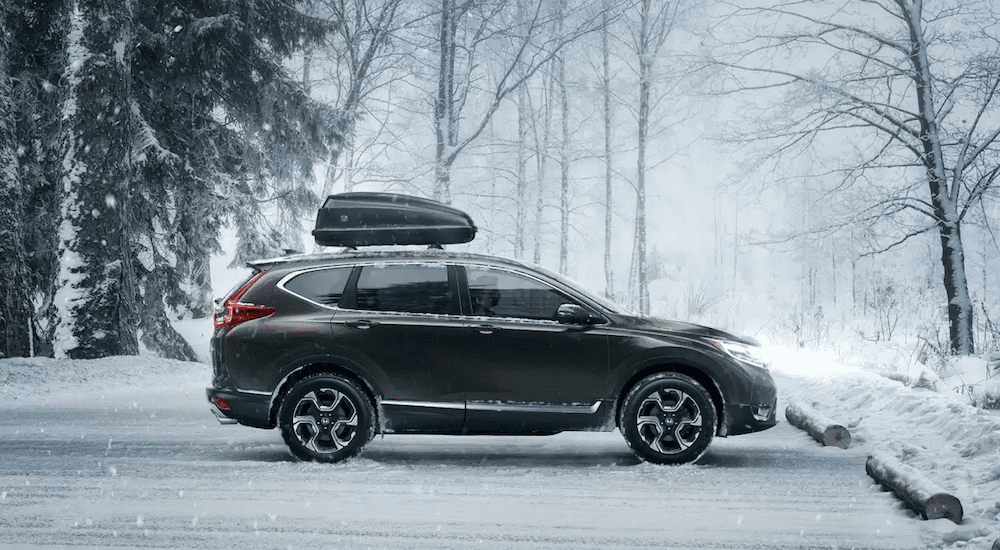One of the most repeated, but accurate statements about today’s vehicle offerings is the mention of the Crossover / SUV vehicle class, and the extent to which it is over-saturated. Every manufacturer on the planet has something to offer, which lessens the likelihood of any one car standing out in comparison to another. Having grown accustomed to debating over minutiae in most cases, it’s reassuring when we compare two vehicles with a more noticeable disparity.
The benefit is that we can recognize the manufacturers who are making choices worth noting, and cue the companies with less successful innovation to step up their game. Case in point: the 2017 Honda CR-V vs 2017 Hyundai Santa Fe Sport.
Price
What better place to start? After all, our choice should always best fit our budget.
That said, the Honda CR-V starts off at $24,045 MSRP with its (base) LX trim. Stepping up through the additional trim options, we have the EX which starts at $26,795. The EX-L comes in at $29,295 and the Touring sets the bar high at $32,495.
The Santa Fe Sport is served up with several different trim options. The base level is accessible at $25,350 MSRP. From here there is a degree of leap, with the 2.0 starting at $31,700. The top-of-the-line 2.0 Limited Ultimate maintains this gap coming in at $36,500 to start, but there is the option of Front or All-wheel Drive for all of the trim options.
With this in mind, the CR-V takes an early lead, being more price-competitive at each trim level. While this may be reflective of a disparity in amenities, we’ll cross that bridge when we get to it.
(1:0 Honda)
Performance
Under the hood of the base CR-V you’ll find a 2.4-liter 4-cylinder that serves of 184 horses and 180 lbs-ft of torque. Stepping up to the EX trim, you can upgrade to a turbocharged 1.5-liter that will deliver 190 horsepower and 179 lbs-ft. In terms of trim level, you can expect 31-34 mpg highway and 26-28 mpg city.
By all accounts, the CR-V rates extremely high in terms of acceleration, handling and performance. The current redesign delivers a sportiness that has been missing in recent model years.
The Santa Fe Sport is powered by a 2.4-liter 4-cylinder engine that delivers 185 horsepower and 172 lbs-ft of torque. Outside of the base trim, there is the optional upgrade to a turbocharged 2.0-liter 4-cylinder which jacks the output to 240 horses and 260 lbs-ft of torque. Regardless of the powertrain option chosen, you can expect to average 22-23 mpg overall (26-28 highway, 19-21 city). While commendably-powered, these are below-average fuel economies, at best.
That said, the Santa Fe rates as average in terms of acceleration. In fact, “average” is an appropriate term to use across the board. Whether in terms of handling, braking or overall drivability there is little about the Santa Fe Sport that is considered “sporty,” or that stands out among its class.
Despite consistent horsepower and torque ratings, the CR-V boasts significantly better fuel economy and grains a growing lead over the Santa Fe Sport with more favorable reviews of its overall performance (2:0 Honda)
Exterior Design
Regardless of trim level, we have no real complaints about the design of the CR-V. While it has undergone an aggressive redesign, the high marks are focused on areas other than its superficial appearance. That’s not a bad thing, mind you, as you can’t judge a book by its cover.
In terms of design, the Santa Fe Sport boasts clean contours and a clear intent of design. That said, it does little to shine and comes across as a very “by-the-numbers” approach to crossover styling.
In all fairness, exterior design is probably a draw between the CR-V and the Santa Fe Sport. There’s certainly nothing wrong with either, it’s just that neither makes our heart skip a beat, and we’d expect most people to feel the same.
(2:0 Honda)
Interior Design
Updated for the 2017 model year, the CR-V does very little wrong. The overall aesthetics are more daring and stylized, yet retain the overall practicality of previous models. A master course in how to successfully update a vehicle, the CR-V marries style and function, while creating one of the most roomy small crossovers available.
Overall, the interior design of the Santa Fe Sport is similar to the exterior, as it’s somewhat pedestrian. This is not necessarily a criticism, as everything is designed in a very functional manner, but it does little to convey a sense of exclusivity one might expect, especially at the higher trim levels.
No real competition on this one, with the CR-V worthy of praise. Perhaps the Santa Fe can take some cues in terms of successful updating, and serve up something better next year.
(3:0 Honda)
Infotainment
For starters, the CR-V comes Bluetooth-enabled with a four-speaker sound system, CD player, and USB connectivity. You really need to explore the higher trims to get the payoff of a 7-inch touchscreen, satellite radio, and music streaming. The top-of-the-line Touring trim comes with an enhanced sound system and HD radio.
At the base level, the Santa Fe Sport comes Bluetooth-enabled with a six-speaker sound system with CD player, satellite radio, and USB / audio input jacks which ticks all of the primary boxes of today’s expectations. Factor in a 5” display screen with a rearview camera, and we have no real criticisms.
That said, the Santa Fe earns the win on this one.
(3:1 Honda)
Final Results
All things being equal, it appears as though the 2017 redesign of the Honda CR-V was instrumental in helping it stand out against the likes of the Hyundai Santa Fe. In fact, its fair to say that prior to the update the two stood fairly close to one another.
Ultimately, the CR-V outshines the Santa Fe in nearly all areas compared.




